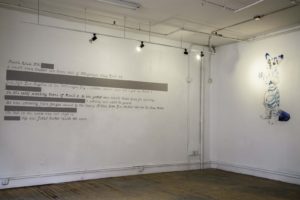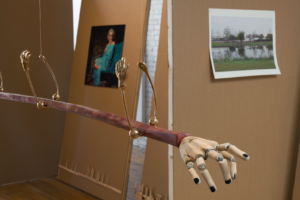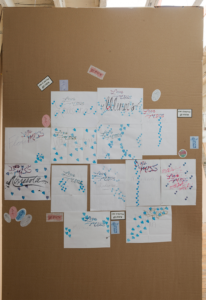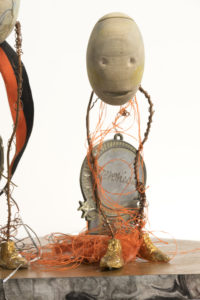“I’ve been haunted my whole life, and I really believe in it. I think history is alive,” Victoria Haynes says about growing up in a pre-revolutionary war house in Ridgefield, Connecticut in her Brooklyn studio. She speaks with conviction, leaning forward as she tells me about the home she and her family shared with ghosts of American Loyalist soldiers. “But we were never really afraid, just kind of fascinated.”

During an hour-long conversation, the New York-based artist seems to conjure up the spectres of historical figures and folk heroes who she sees as unlikely collaborators. There’s Johnny Appleseed, the Swedenborgian missionary who introduced apple trees to the continental United States and, Jim Sullivan, the folk singer-songwriter and rumored alien abductee. There’s also photographer Lee Miller, an artist who was underappreciated in her own time due to both her gender and her role as a studio assistant and one-time partner of Man Ray. Laser prints of suburban Google Street View screenshots and Young Adult historical fiction book covers are pinned on the walls and embellished using ink and pencil. It’s all part of a process that includes a significant period of research and discovery. Through it, Haynes emulates a forensic scientist, an archivist, or a biographer, as she takes trips to specific monuments, museums, and archives to access primary source materials.
Last year’s Decision Kit for Miss Fortune, a solo exhibition at New York’s Gern en Regalia, which ran from October 6 to 31, epitomizes the artist’s longstanding concern with overlooked women of American history. Delving into the life of American Gothic writer Shirley Jackson, the artist visits the 20th century novelist’s extensive archive in Washington D.C.; some drawings from her journals are carved into a freestanding sculpture, while other excerpts are xeroxed, redrawn, obscured using charcoal dust, and recombined into wall-mounted aggregates. As Haynes iterates on Jackson’s symbol set using a combination of bronze castings, hand-carved wooden mannequins, Levi’s jeans stickers, and illustrative drawings, the work develops a life of its own. The physical refuse of the novelist’s life becomes a ground upon which Haynes is able to refer to motherhood, storytelling, and ritual.

Following her research, Haynes always returns to the realm of fiction. After all, if history is alive, then it can be revised or fantasized about. In her Notable American Women exhibition, Haynes describes herself simultaneously falling in love with, and becoming, the figure of her intrigue. In a gesture Haynes describes as “museological parafiction,” she imagines what an exhibition curated by the aforementioned Lee Miller would look like. The photographer’s life is not represented in the works themselves, rather it is a point of departure. Miller’s self-portraiture motivates Haynes’ own meditation on self-representation, taking the form of ‘Love miss america (correspondences 2016-18)’, in which Haynes attempts to source handwriting samples from all 50 states. Below, we discuss the ethics of this project, how the artist relates to her subjects through the immediacy of the Internet, and exploring the American landscape.
**The idol figure is an impetus for your work. Could you talk about where that comes from, what makes for a good idol, and what the process for entering into that relationship looks like?
Victoria Haynes: I work a lot with fiction as a starting point. Many of the narratives that I work with converge around a central figure. I often begin working from biographical material. I find myself falling in love with the person that I’m researching — of late, they’ve been female authors and artists who I feel a certain affinity towards. I see parts of myself in them, or project my own biography onto theirs, or look to them kind of as role models.
I’m looking to go from a fictional story about these people, into their biography, and from there into primary source material to try to open up a ‘real relationship’. I’m always trying to find some way to actually relate to them, which is, of course, totally impossible. But that feels like a product of the immediacy of the internet. I can pull up information about them on my phone, see pictures, find out ways to travel to places where artifacts that they’ve touched are stored, and I can do that continuously as I go about my day. So there’s something that can make it feel that they’re as present as my friends, which is really strange, and seems particular to how we live now.

**Two of the figures that stuck out to me were Lee Miller and Shirley Jackson because part of their legacy is that they were overshadowed. When I was reading about Shirley Jackson, I came across The Cut’s profile that’s titled ‘The Novelist Disguised As a Housewife’, and Lee Miller’s career was often eclipsed by her relationship with Man Ray. What is it about that condition?
VH: That article in The Cut is one of the few that describes Shirley Jackson and her husband’s relationship that way. A lot of the older writing about them describes the relationship with much more nuance. I think it’s partially the revisionist in me, that’s excited to have access to these women and have a chance to rework some of the narratives. Shirley Jackson is really interesting, because there’s not that much writing about her but there are 52 boxes of archival material available in the Library of Congress. It’s a massive amount of source material with not a lot of biographical work. So I was able to pose as biographer, curator, or museum director. Of course, as an amateur you miss stuff and you make mistakes, which for me is part of the total absurdity of working like this.
**You operate within various professional capacities — absorbing other fields into your practice. What is that process of translation — to go from biographer to making bronze sculptures, furniture-esque objects?

VH: We’re in this age of interdisciplinarity but we’re also in a work environment in which you’re constantly switching roles, constantly camouflaging, or playing up different parts of yourself to find work. I navigated college and post-grad working odd freelance jobs. It feels like that’s the condition of someone who makes anything today.
I do want to push back against that logic though. My interest in craft tracks with my family history, and where I’m from. That gives me a base, so I don’t feel lost in a sea of options and tastes, which I think is really important; I don’t know how I would manage without that. My grandfather was a mechanical engineer who made significant contributions to forensic science doing accident reconstruction for car crashes. My dad also has a background in engineering but went on to work for the CIA doing early work with metadata. He was part of a team of developers that figured out how to get a 12-inch high stack of papers whittled down to two inches without losing anything crucial.
So, there’s a physicality to dealing with information that my family has been involved with for generations, and much of my upbringing was about physical puzzling. I’m always moving my hands when I’m thinking — so I really enjoy carving, for instance, because it allows me to actually move a thought around.
**Do you always work directly with primary sources?

VH: I think archival materials are often products that people save but are also the refuse of other people’s incidental materials. I was touching Shirley Jackson’s notebooks that had marks on them, napkins with a sketch on them. When I did research on Johnny Appleseed — which was the first big research project I undertook — the interesting thing was he didn’t leave a lot of physical traces behind because he was always on the move. The most precious thing that he had was this bible, which was amazing to see because all the pages were frayed at the edges, which just showed you how many times he thumbed through it.
Because he left nothing behind, the things that were in the Johnny Appleseed Museum at the University of Urbana were cultural artifacts that people have made about the legend. It kind of felt like a creepypasta [online horror stories that are widely circulated on forums and social networks through copy-and-pasting] — pictures of people that impersonate Johnny Appleseed, models of his cabin, Walt Disney’s score for the movie about him — it was all secondary material. Pure fiction. So I was interested in making fiction about those as though they were primary biographical source material.
**The other thing that stood out to me about the textual sources and historical figures that you refer to is that they’re mostly American, or refer to folkish histories.
VH: I make small gestures, small fictions, and tiny versions of these narratives. And these things are themselves part of a landscape that’s local to me. Part of it, too, is resisting the idea that artists have to be able to be flexible and everywhere — like the globally-exhibiting artist whose work can contextually make sense in Shanghai and Berlin, and so on.

I’m also just fascinated by American history and I have been for my whole life. I’m fascinated with the geography of America. I’m fascinated by state borders and the geography and topography that divides the land against these borders. My family traveled from the mountains in West Virginia to the south, then my nuclear family moved north to an urban port. So there’s a movement within relatively small bounds that I think has had significant ramifications in my own family history. And I think that’s a common experience for many American families.
I would like to make work about, and continue learning about America until I die, and I would also like to travel within America as much as possible. In that way, I do feel there is urgency. I think it’s an important time to be here and to be looking at our mythologies.
**Depending on the topic, it seems like you could encounter some issues with the appropriative aspects of your practice. How do you navigate the ethics of the archive?
VH: It’s something that I really wring my hands about because I see a lot of practices that navigate this really well, and others that don’t. The key for me is to try to risk myself, or involve myself, as one would do in a relationship — become an active participant so that something in me could be lost. Working feels like that risk — taking these strange trips, doing these elaborate actions, putting in time to learn, meet, and talk to people, and allowing myself to become attached feels active in that way. There’s an adventurous sensation to being inscrutable in these spaces, with no official purpose, and going around with my weird over-the-counter tools. There’s also the risk of wanting to make work about America in a time where these signifiers are very charged.

I had done this project [Love miss america (correspondences 2016-18), exhibited as part of Notable American Women] over several years of collecting handwriting samples of people in every state because I wanted to make a master American font. Most of the participants were strangers, and most of them were older — I was using all these online platforms like Craigslist, Couchsurfing, Facebook local tourism pages, and so on. I got a lot of hate mail, which was like, “you’re going to use our labor for free, to make some exhibit in New York that has nothing to do with us”. And you sit there and you say, “yeah, this feels really bad,” so you try to give back in some way, which can be paying them, which some people wanted, or just sharing documentation or writing letters, or giving credit.
There’s a lot of emotional labor involved in my work. I think it reads as an impressionistic feeling but I never anticipate it. For Decision Kit for Miss Fortune, I walked around after doing that research trip feeling completely hollowed out — I felt like I was part of that family. I felt devastated by her death, her literary career, and what didn’t happen for her. It was incredibly strange. I couldn’t work on anything for a while, which I think is important. I want to be right in the syrup of that.**













